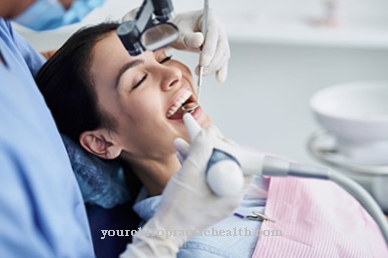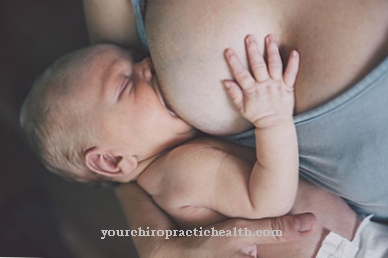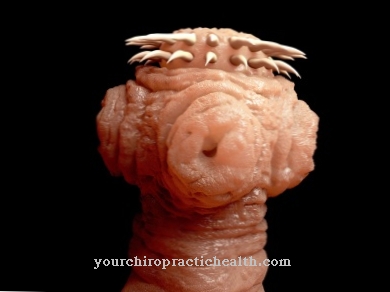Many people suffer from food allergies these days.In some people, however, no food allergy can be diagnosed and still they have a wide variety of intolerance reactions to food. It could be a Histamine intolerance or. Histamine intolerance act.
What is histamine intolerance?
.jpg)
© ipopba - stock.adobe.com
The term Histamine intolerance Characterizes an imbalance in the body between the amount of histamine that is consumed and the amount that is broken down. In the body, the enzyme diamine oxidase breaks down histamine, which is supplied in different concentrations by food.
If this is not produced in sufficient quantities, the body reacts with various intolerance reactions such as diarrhea, stomach irritation, tiredness, asthma, dizziness, skin rashes, nausea, etc. This is an acquired disorder, genetic evidence is lacking so far.
causes
One of the main causes of one Histamine intolerance lies in the concentration of the intake of foods rich in histamine. Many foods are not naturally rich in histamine, but become so through ripening and fermentation.
Particularly high levels of histamine are found in foods to which bacteria have been added, e.g. B. in smoked meat, smoked fish, red wine, cheese, sauerkraut and wheat beer. But so-called histamine liberators (foods that stimulate the release of histamine in the body) are also responsible for an intolerance. These histamine liberators include: a. Strawberries, egg whites and fish.
Alcohol also promotes the release of histamine and reduces its breakdown. Medicines also impair the breakdown of histamine in the body, for example antitussive drugs, sleeping pills, painkillers and rheumatism drugs.
Symptoms, ailments & signs
Histamine intolerance manifests itself in very unspecific complaints, the most common being digestive complaints, skin rashes and migraines. The symptoms can appear immediately after consuming histamine-containing food or drinks, but also hours later. If the digestive tract is affected, the histamine intolerance is uncomfortably noticeable through abdominal pain, stomach cramps, gas, nausea and heartburn.
Diarrhea and vomiting are also possible. In many cases, headaches and migraines are caused by a histamine intolerance. They are sometimes associated with dizziness, circulatory problems and palpitations, but these symptoms can also be signs of histamine intolerance on their own. Skin reactions show up in the form of rashes, severe itching, swelling and the formation of wheals.
The so-called "flush" is characteristic, especially after drinking alcoholic beverages: In this case, an attack-like reddening of the skin spreads over the neck and face, rarely it also spreads over the upper body. A histamine intolerance can also affect the respiratory tract: Possible symptoms are irritation of the throat, shortness of breath up to asthma-like attacks of suffocation, increased sneezing and a blocked or runny nose.
Occasionally, swelling of the lips and eyes is observed, and sleep disorders, depressive moods, water retention in the tissue, fatigue and joint pain can in some cases be attributed to histamine intolerance. In women, histamine can affect the hormonal balance and cause menstrual disorders.
Diagnosis & course
More and more people are of the Histamine intolerance affected, especially middle-aged women. Although widespread and recognizable by many symptoms, histamine intolerance is still relatively unknown.
Many people have to walk from doctor to doctor before attentive doctors recognize their symptoms as histamine intolerance. It cannot be detected by the usual food allergy test, since it is not an allergic reaction.
A diagnosis can often only be made through a blood and urine test and a reduction diet that restricts the intake of foods rich in histamine. A provocation test, in which histamine is intentionally administered, and a food diary can also provide information.
Numerous complaints after consuming histamine-rich foods can indicate histamine intolerance:
- Rashes (itching, redness, nettles, wheals, eczema)
- Headache, migraines, sometimes with dizziness and feelings of heat
- Runny nose, difficulty breathing, asthma, sore throat
- Flatulence, bloating, nausea / vomiting, heartburn
- high blood pressure, low blood pressure, palpitations or extrasystoles
- Exhaustion, excessive tiredness after eating food
- Aggravation of menstrual cramps, bladder and urethral infections
- Irritations of the mucous membranes
- Water retention
- Joint pain
Complications
Histamine intolerance leads to many different complications and complaints that can extremely limit the life and everyday life of the person affected and reduce the quality of life. As a rule, the intolerance leads to severe reddening of the skin and the development of itching. There is also nausea with dizziness and the patient suffers from severe vomiting.
In the abdominal region there is pain and cramps, which in many cases leads to irritability and restrictions in everyday life. Not infrequently, the patients also suffer from headaches and a runny nose and runny nose. For many patients, the symptoms can also lead to psychological impairments and depression. In severe cases, histamine intolerance can also lead to breathing difficulties, so that patients suffer from shortness of breath and gasping for breath.
There is also usually relatively severe joint pain and general exhaustion. In acute emergencies, the symptoms can be treated with medication. In general, however, those affected by histamine intolerance have to forego certain foods and are therefore restricted in their diet. However, there are no further complications if the patient refrains from these foods.
When should you go to the doctor?
If symptoms occur again and again after consuming histamine-rich foods, it may be due to histamine intolerance. A visit to the doctor is indicated if the symptoms affect your well-being or cause serious complications. Symptoms such as nausea and vomiting, severe rashes and breathing difficulties should be clarified by a doctor. Women should seek medical advice if they experience recurring menstrual cramps after consuming certain foods.
People who experience breathlessness, sweating, or impaired consciousness after eating are best to go to a hospital. In the event of a shock reaction, the emergency services must be called. In general, those affected should have a suspicion of histamine intolerance clarified. With a medical diagnosis, the disease can be treated in a targeted manner and further complications avoided. Parents who notice signs of allergy or intolerance in their child are best advised to speak to their pediatrician. In case of doubt, the emergency medical service can be contacted first. If you have other symptoms, you should ideally speak to a doctor immediately. In addition to the general practitioner, a specialist in internal medicine can also be consulted.
Doctors & therapists in your area
Treatment & Therapy
Because foods rich in histamine are the main cause of the Histamine intolerance form, the most important treatment method is to know histamine-rich foods and to reduce them in the menu or to avoid them completely, if possible. The following foods are particularly rich in histamine and should be reduced or avoided:
- red wine
- Wheat beer
- mature cheeses such as Emmentaler, Tilsiter, etc.
- Salami, ham
- Smoked fish, canned fish
- Vegetables like spinach, sauerkraut
- Restriction of the histamine liberators citrus fruits, bananas, strawberries, raspberries, pears, walnuts, chocolate, cocoa, legumes, wheat germ
- Avoidance or restriction of preserved foods
In addition, the release of histamine in the body can be stabilized with medication or antihistamines can be administered. Many doctors are still trying to combat symptoms symptomatically because they don't put the symptoms in context. But that doesn't help those affected.
Outlook & forecast
The prospect of getting a grip on typical symptoms of histamine intolerance or histamine intolerance depends on various parameters and the countermeasures taken. The problem lies in the fact that various influencers are involved in histamine intolerance. Histamine is also a maturation hormone that can be found in numerous foods. Hardly anyone can avoid this hormone entirely.
Histamine intolerance is triggered either by foods containing histamine, or by histamine liberators and biogenic amines. Some foods contain only one of these triggers, while others contain two. If the latter can be avoided and the other foods are consumed as rarely as possible, the prognosis is good. Avoiding long and artificially ripened foods with high levels of the ripening hormone is an important measure.
Another option is the rotation diet. This can improve the prognosis with the supply of changing and low amounts of histamine. It is also possible to take an enzyme called diamine oxidase, or DAO for short. If this is taken before meals containing histamine, the symptoms can improve. It is advisable to prepare food with the help of special cookbooks. Attending appropriate self-help groups can also be helpful in the case of histamine intolerance.
It becomes problematic if the histamine intolerance occurs as a result of a long-standing lactose intolerance or is accompanied by other food intolerances. In this case, the prospects for complete freedom from symptoms are significantly worse.
prevention
The most important prevention in a Histamine intolerance consists in avoiding or limiting foods rich in histamine. Once the intolerance is known, it is relatively easy for those affected to identify which foods they are particularly sensitive to.
There is no direct prevention because the disorder is acquired and depends on the levels of histamine in the body. Because the concentration of histamine in canned foods is particularly high, fresh cooking can be one of the most important preventive measures.
As a person affected, you should limit or avoid preserved foods, because the histamine concentration depends on the degree of ripeness. Each person concerned has to find out individually which concentration is tolerated.
Aftercare
Affected people must adhere to the change in diet and avoid foods containing histamine and histamine liberators. In the beginning, lists help to note down all the prohibited food ingredients and take the time to study all ingredients for their tolerance when shopping.
As soon as symptoms such as headache, rashes, shortness of breath or indigestion occur again, it is advisable to keep a food diary. All food, medication and symptoms consumed are recorded in this and evaluated after a while. A well-kept diary then shows parallels in symptoms and makes it easier to identify other intolerable foods.
It is important to have a list of incompatible drug ingredients with you and to hand this over to any attending physician. Nevertheless, it is advisable to check the list yourself in advance for each prescription and injection. This is particularly important with regard to upcoming operations, but also with anesthetic injections at the dentist.
Carrying an emergency ID card with you in your wallet can help in medical emergencies in which you are no longer able to provide information on intolerance yourself. Such an ID can be requested free of charge on the Internet. In the event of life-threatening symptoms, you can talk to your doctor about prescribing an EpiPens in an emergency.
You can do that yourself
If histamine intolerance has been found, the diet must be changed. Since it varies from person to person which foods and drinks are tolerated, those affected should create a nutrition plan. If the typical complaints arise after consuming a certain food, this should be entered in the "red list" and avoided in future.
In general, foods rich in histamine such as long-term seafood, fresh fish, meat and cheese, and fermented foods such as sauerkraut must be avoided. In some allergy sufferers, bananas, avocado, tomatoes, spinach, strawberries, pineapples and nuts release histamine in the body. It is advisable to eat many foods with vitamin B6, manganese, and zinc because these substances relieve symptoms. Dietary supplements can be taken in consultation with the doctor.
However, if foods containing histamine are consumed, the symptoms should be cured with bed rest and natural pain relievers. The symptoms usually go away after a few hours and no medical treatment is required. In severe cases, drug treatment with diamine oxidase preparations can also be useful. Histamine intolerance should be diagnosed in any case, as this is the only way to ensure targeted treatment.

.jpg)











.jpg)

.jpg)
.jpg)











.jpg)